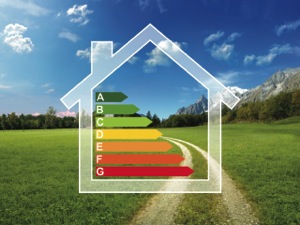
We hear the word sustainability bandied about these days and this week we’re taking a look into what makes a house “sustainable” and the many virtues of this approach. Sustainable building, also called green building, is a method of maximizing the energy efficiency of our homes so that natural resources are not depleted and our homes waste as little of our valuable energy sources as possible.
This a general definition, but there is a lot more that goes into making a home sustainable, like the basic design, layout, orientation, size and use of natural, non-toxic and economical building materials. In addition to minimizing the need for energy, water and other resources, other goals include making the homes healthful, sourcing materials from local vendors and reducing waste and environmental losses.
It is a misnomer that “sustainable” homes are more expensive to build or buy. In fact, many of the basic elements of “sustainability” are designed to bring down both building and operating costs. Simply orienting a house to maximize solar gain is a technique that will save homeowners a bundle, as is reducing the size and footplate of homes, designing for cross ventilation, and making energy efficient choices in appliances and fixtures.
There appear to be opposing trends in building today. On the one hand, you have the over-sized mega-mansions being built for pure indulgence, and on the other, an environmentally conscious segment seeking to both build green, and to retrofit, as best as possible, their existing non-green homes.
Efforts are being made in the latter category right in our own backyard. The Del Sur community in San Diego is one example. It describes itself as a progressive and eco-friendly community as it has followed the guidelines of the Sierra Club and LEED certification programs. A master-planned community, it makes use of solar power in many homes, as well as mandatory tankless water heaters and weather based satellite irrigation systems. Only low toxin paints and glues are utilized in the homes, and common buildings and parks allow residents to reduce their individual footprints.
Another community in Pleasanton called Castle View has made recycling a prime feature of the community which pumps, purifies and recycles its own water to grow grapes and other crops. This system is computer generated and even more importantly, driven by windmills and solar power.
Another builder, Pardee, has created the concept of “Smart Homes” for its master-planned communities. Their advertising says they are committed to dedicated open spaces, habitat restoration, public transportation, walking trails and recycling. Their hallmark is better insulation, thereby reducing the need for air conditioning and heating.
When we build and retrofit “sustainable” homes, we are not only making a contribution to preserving our environment for the future, we are selfishly adding to our own economy and comfort, while making our homes more practical, efficient and durable. Many have attested that small, well insulated, airy homes are in fact more comfortable to live in than the giant boxes that are emblems of wealth in our society. There may come a day when clean air and water are more valuable and prized than any other commodity. Let us add “sustainability” to our real estate vocabulary!












all of this backwards implementation of “sustainability” is coming to us via a global group of special interests via the San Diego Foundation. They funnel the money through there to push for all of these things. Little do you all realize all of these things are just items in a checklist that will make San Diego exempt from CEQA aka will give developers free reighn.
Its why non-profits for all this “biking” like Circulate San Diego are being run by people like Stephen Haase, the guy developing Mission Valley who used to be head of development services at the city. and Jim Maddafer–remeber him. Look it up.
The city adopted ICLEI in 2011 which is a global takeover of SD by special interests. There is a reason this is all so backwards.